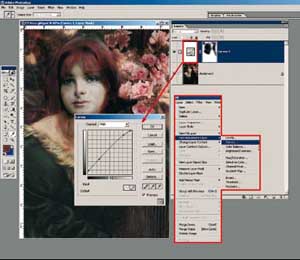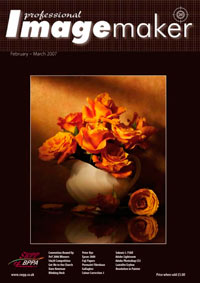articles/Photoshop/colourcorrectioncurves-page3
Colour Correction - Curves and Adjustment Layers - part 3 of 1 2 3 4 5
by Mike McNamee Published 01/02/2007
There is a huge difference between performing (or watching) colour correction at a seminar and the real world of colour correction. Usually at a seminar the speaker has worked though the correction beforehand and has a reasonable handle on what is going to be needed to achieve a satisfactory result. The reality of facing an image for the first time is a little more complex and can require a couple of starts before the desired result is achieved.
The example we chose to show here is typical. Originally, artist Carol Tipping had created her image and printed it to her satisfaction at A4 on an Epson 1290. The print matched the screen and she liked the result. To your Editor's shame he did not properly examine the image in Photoshop before committing to the printing of a 30" print onto the rather expensive Epson Somerset Enhanced, a 500gsm archival board material. The first print out was massively blocked up in the shadows with all the gorgeous brushwork completely hidden and not what the artist had intended at all. Suitably chastened we went back and followed the advice we always give out - look at the number values of the colours before you start.
The eyedropper was set to 5x5 average (ie 25 pixels per measurement) and run around, over the dark folds of the clothing. This revealed that none of the RGB values got above 30 points and many were down at 5 points. We knew from our profiling and ColourAudit data that such values printed as fully dense black and, had we had the foresight to measure first, we would have realised!

The trick is to make an Adjustment Layer for curves and lift the density of the darkest tones until they are no longer blocked and therefore start to print. If you have made and printed a grey scale as described in part 2 of this series you will have determined which RGB values (if any) fail to differentiate. This tells you which values to avoid in your image if shadow detailseparation is required. The problem is particularly acute with Somerset (and other) fine art papers, which tend to absorb ink deep into their structure (see the boxes). We limited the black output values to 21 RGB points by lifting the left-hand base of the curve upwards as shown in the screen grab. Carol did not want the face of the girl or the roses to be lightened and so the mask (which is provided by default with an Adjustment Layer) was painted with black and dark greys to protect those parts of the image from being lightened by the Adjustment Layer.
Please Note:
There is more than one page for this Article.
You are currently on page 3
- Colour Correction - Curves and Adjustment Layers page 1
- Colour Correction - Curves and Adjustment Layers page 2
- Colour Correction - Curves and Adjustment Layers page 3
- Colour Correction - Curves and Adjustment Layers page 4
- Colour Correction - Curves and Adjustment Layers page 5
1st Published 01/02/2007
last update 09/12/2022 14:52:40
More Photoshop Articles
There are 16 days to get ready for The Society of Photographers Convention and Trade Show at The Novotel London West, Hammersmith ...
which starts on Wednesday 14th January 2026





